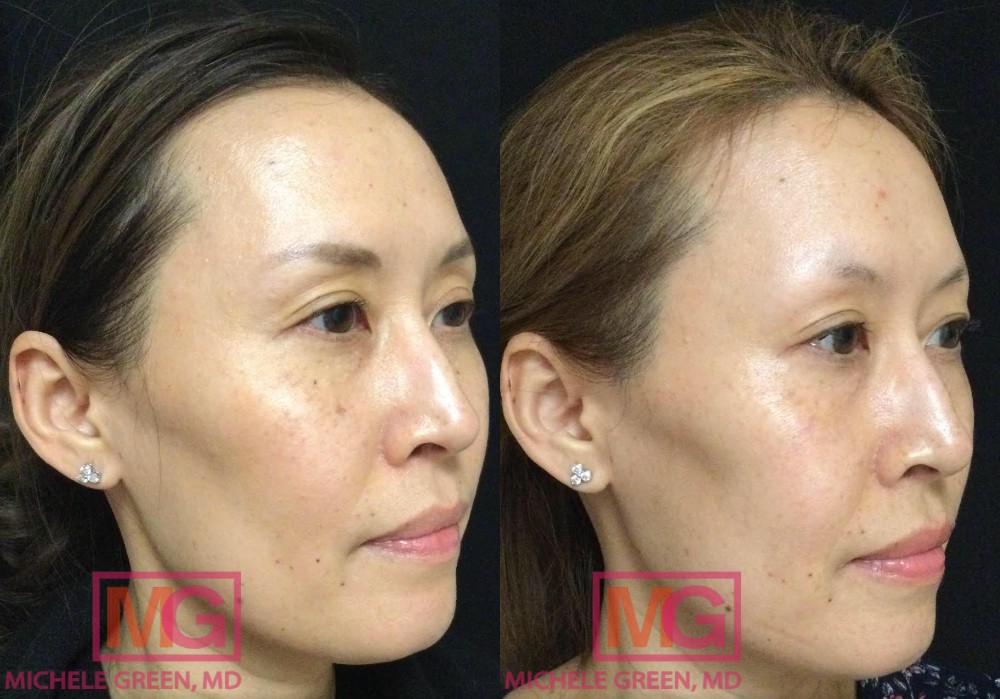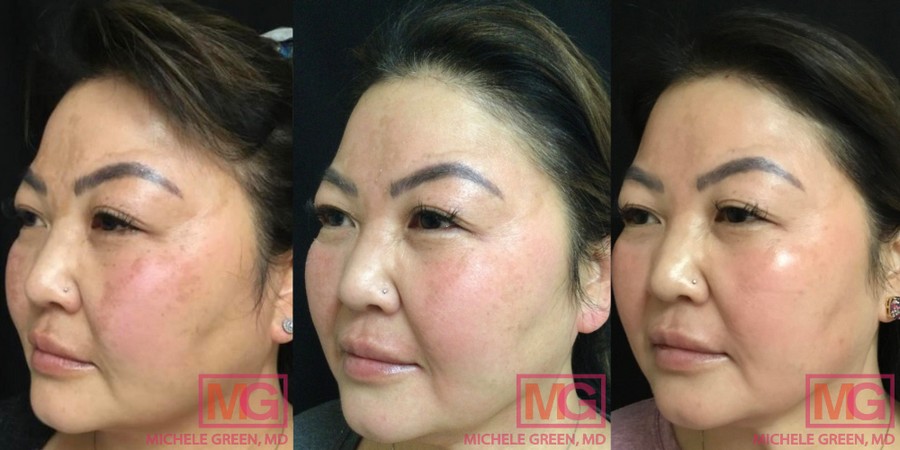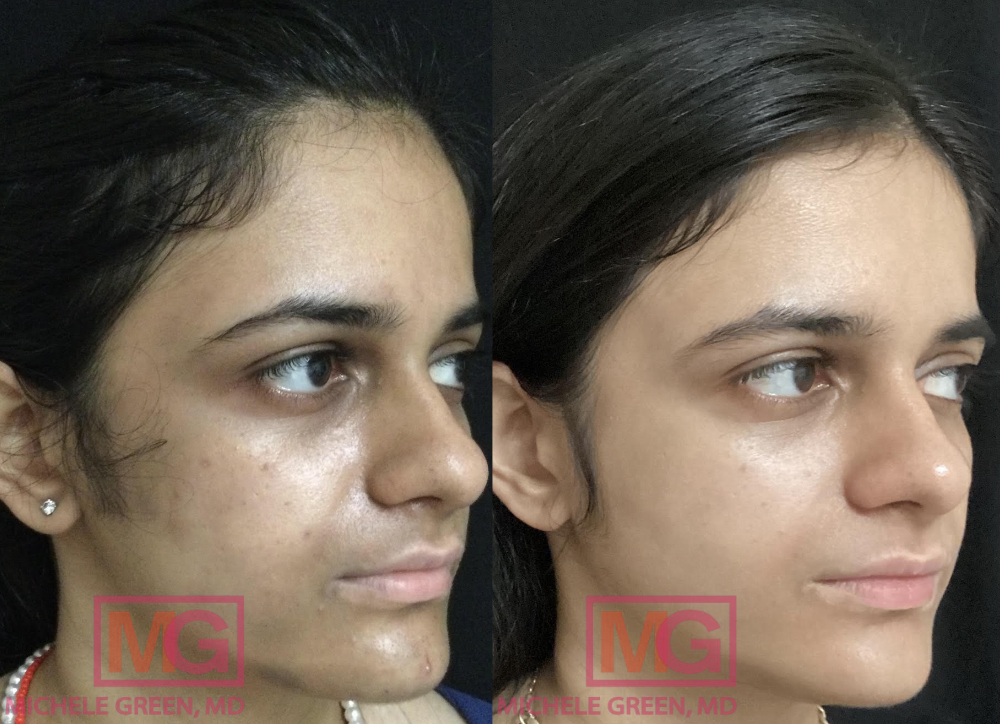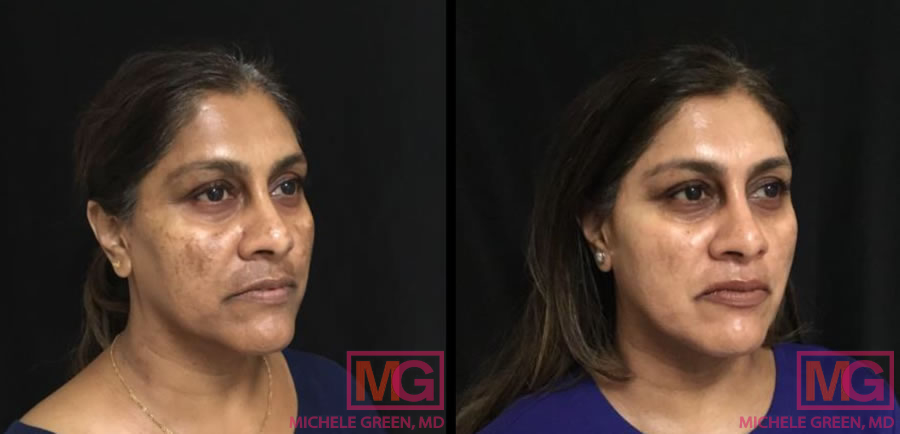Melasma in Asian Skin
Melasma is a skin condition characterized by brown or gray dark spots on the skin’s surface, most often on the face. While the skin condition is prevalent, especially in women of Asian descent, it is difficult to treat and can recur frequently. Asian patients are frequently at a higher risk of developing melasma due to the higher concentration of melanin in the skin than Caucasian patients. Sun exposure, air pollution, and hormone fluctuations during pregnancy or adolescence are all risk factors that can exacerbate melasma, causing dark splotches to form on the face and making many patients feel self-conscious. Luckily, expert, board-certified dermatologist Dr. Michele Green has many treatment options at her New York City dermatology office. With many years of experience treating patients of Asian descent, Dr. Green is a master at treating Asian skin and knowing which treatments are safe and effective for you.
While melasma is impossible to cure completely, the hyperpigmentation of the skin can be significantly reduced through the use of various treatment strategies, including chemical peels, such as the Cosmelan peel or Mesopeel, microneedling, topical treatments, such as hydroquinone, Tretinoin, or tranexamic acid, and the VBeam laser. Regarding laser treatment, Dr. Green knows that not all lasers are safe for Asian skin. Ablative lasers, fractional lasers, and intense pulse light lasers can all cause hyperpigmentation and worsening of melasma in Asian skin, so it is imperative to choose a physician who knows how to care for Asian skin, such as Dr. Green in Manhattan.
Board-certified dermatologist Dr. Michele Green has been expertly treating patients of all skin types and skin tones at her Upper East Side New York City dermatology office for more than 25 years. Experienced in a wide range of treatment options, Dr. Green knows which laser treatments and chemical peels are safe for Asian skin and which need to be avoided. In addition to her work in treating all forms of hyperpigmentation, including melasma, sun spots, acne scars, and rosacea, Dr. Green is an expert in skin rejuvenation, offering such treatments as Botox, dermal fillers, skin tightening, and more. Well-known for high patient satisfaction, Dr. Green has consistently been voted one of the best healthcare providers in New York City by such publications as Castle Connolly, Super Doctors, and New York Magazine.
Skincare for hyperpigmentation on Asian skin
Asian skin is more susceptible to hyperpigmentation than Caucasian skin due to a higher concentration of melanin in the skin. This can mean a higher incidence of dark spots caused by sun damage and a higher risk of post-inflammatory hyperpigmentation due to improper laser use on Asian skin. The most crucial skincare step for preventing hyperpigmentation in Asian skin is to apply a broad-spectrum sunscreen of SPF 30 or above at the start of every day and reapply every two hours or immediately after heavy sweating or contact with water. Using sunscreen can help prevent hyperpigmentation, such as sun spots and a flair-up of melasma. It is also essential to select a healthcare provider who is familiar with treating Asian skin, such as Dr. Green, for treatment options that are safe and effective for your skin type.
What is melasma in Asian skin?
Melasma is a common yet difficult-to-treat pigmentary skin condition characterized by brown or gray dark spots that appear most commonly on the cheeks, nose, chin, forehead, and jawline. The condition can be triggered due to several risk factors, including sun exposure, hormone fluctuations, environmental conditions, and genetics. Hyperpigmentation, discoloration, and dark spots such as those associated with melasma appear on the skin’s surface due to the overproduction of the skin pigmentation melanin in the melanocytes, which are cells in the body responsible for producing melanin. All people have the same amount of melanocytes in their bodies, but the amount of melanin produced in the skin varies from person to person, which determines skin color and skin type. Asian skin typically produces more melanin than Caucasian skin, which puts Asian patients at a higher risk of developing hyperpigmentation conditions, such as melasma, sun spots, acne scars, age spots, and seborrheic keratosis.
Melasma is one of the most challenging skin conditions to treat, as the reaction between the melanocytes and other cells in the epidermal and dermal layers of skin constantly shifts, making disease recurrence likely. While melasma dark spots tend to have irregular borders, the condition is harmless and does not indicate skin cancer. If you notice new, growing, or shifting lesions or dark spots on the skin’s surface, it is always best to contact a board-certified dermatologist, such as Dr. Green, to ensure the spot is benign.

What is the best treatment of melasma on Asian skin?
While melasma is a harmless skin condition and not an indicator of skin cancer, the discoloration occurs most frequently on the face, meaning the condition is obvious and can often make patients feel self-conscious. One study found that 94.1% of patients with melasma were unhappy or bothered by the skin condition, with nearly 79% feeling unattractive and nearly 65% feeling embarrassed. Luckily, the appearance of melasma can be lessened when treated appropriately. When treating melasma on Asian skin, it is essential to seek out an expert dermatologist, such as Dr. Green, who is very familiar with treating all skin types and knows what treatment options will be safe and effective for your skin tone. Due to the higher production of melanin, Asian skin is more prone to post-inflammatory hyperpigmentation (PIH), when dark spots form on the skin’s surface following improper treatment, and hypopigmentation, when white spots form at the treatment area. With years of experience treating Asian skin, Dr. Green has the best treatments available at her Upper East Side dermatology office, including chemical peels, such as the Cosmelan Peel and Mesopeel, microneedling, skin-lightening creams, and laser treatments. To begin the treatment process, Dr. Green will examine the treatment area to determine the treatment or series of treatments that will be right for you.
How to treat melasma on Asian skin
Melasma is a very challenging skin condition to treat, and there is no cure; however, the symptoms can be lessened via routine topical or laser treatments. However, specific treatments can worsen melasma, especially in patients with darker skin, resulting in hyperpigmentation or hypopigmentation at the treatment area. For example, Asian patients should avoid ablative and fractional lasers, which cause controlled skin surface damage to activate fibroblasts, boost collagen production, and increase skin cell turnover. However, fractional lasers can damage Asian skin, leading to post-inflammatory hyperpigmentation and permanent scarring. Intense pulsed light (IPL) lasers can also treat hyperpigmentation in Caucasian skin but may damage Asian skin, causing PIH or hypopigmentation. Deep chemical peels should also be avoided, as the acid solution permeates into the middle layers of the dermis, which can help reduce the appearance of pigmentation on Caucasian skin but can cause significant damage to Asian skin and patients with darker skin tones. Before beginning any treatment for melasma, it is imperative to consult with an experienced dermatologist, such as Dr. Green, to ensure that you are receiving the safest, most effective option for your skin.

Melasma treatment for Asian skin
While melasma is challenging to treat, several treatment options are safe for Asian skin and effective at reducing the appearance of dark spots on the face. For the most part, Dr. Green prefers to use alternative methods to laser treatments when addressing melasma, as many can worsen the hyperpigmentation associated with melasma. Instead, Dr. Green will turn to chemical peels such as the Cosmelan peel or Mesopeel, microneedling, the VBeam laser, or topical treatments such as Tranexamic acid, hydroquinone creams, or retinoids.
The Cosmelan peel is a type of chemical peel containing azelaic acid and ascorbic acid designed to combat the appearance of dark spots, acne scars, hyperpigmentation, and melasma. The active ingredients in the Cosmelan peel – azelaic acid and ascorbic acid – inhibit melanin production in the melanocytes, decreasing pigmentation in the skin. Following the procedure, the Cosmelan peel can make the skin particularly susceptible to sun damage, meaning that patients should always apply sun protection in the form of sunscreen with broad coverage and an SPF of at least 30 before going outside. The Cosmelan peel can be used on patients of all skin types, including Asian skin ranging from Fitzpatrick scale II-V. The Mesopeel is another chemical peel safe for Asian skin, gently exfoliating the treatment area for total skin rejuvenation. The Mesopeel can be used on the most sensitive areas of the body, reducing the appearance of melasma and providing patients with a more even skin tone and texture.
Microneedling is another effective treatment, particularly when applying platelet-rich plasma, or PRP, and works via applying tiny, surgical-grade needles to the skin’s surface. The needles pierce the skin of the treatment area, causing micro-wounds that trigger the body’s natural healing response, boosting collagen production and promoting skin cell turnover. New skin cells generated at the treatment site are lighter, reducing the appearance of hyperpigmentation, such as melasma, on the skin. Once the skin has been pierced with the needles, Dr. Green will apply the PRP solution of plasma from the patient’s blood, which speeds up the healing process for even better results.
Topical treatments can also effectively reduce melasma’s appearance and work best when prescribed by an expert dermatologist, such as Dr. Green. One such treatment is topical tranexamic acid, which suppresses the UV-activated production of melanin to reduce the incidence of discoloration on the skin. Tranexamic acid is best when applied topically rather than taken orally, as oral tranexamic acid can cause side effects, including deep vein thrombosis and bloating. Dr. Green may alternatively prescribe a skin-lightening cream, such as topical hydroquinone, which prevents melasma’s worsening appearance by inhibiting melanin production in the melanocytes. Hydroquinone should not be taken long-term, as it can lead to more discoloration on the skin. A topical retinoid, such as Tretinoin, can also be used to reduce the appearance of melasma by increasing skin cell turnover, which decreases the appearance of discoloration, fine lines, and wrinkles on the skin and improves skin texture. Topical retinoids contain Vitamin A and can be used for acne and hyperpigmentation treatments.
The VBeam laser is also safe and effective for use on Asian skin to decrease redness due to melasma. The VBeam laser can treat various skin conditions, including rosacea, acne scars, stretch marks, capillaries, and broken blood vessels, by targeting red pigmentation at the treatment area and leaving the surrounding skin unharmed. A pulsed-dye laser, the VBeam laser is non-ablative, considered the gold standard for treating pigmentation, and safe for many skin types. While melasma is very challenging to treat due to the many triggers and shifting nature, many treatment options are available at Dr. Green’s office. The first step in the treatment process is to schedule a consultation with Dr. Green to determine which treatment – or series of treatments – will be safe and effective for you.
Best laser for Asian melasma
When treating melasma on Asian skin, the type of laser that is used but be carefully considered, as many types of laser treatment can cause damage to Asian skin in the form of hyperpigmentation. Research has shown, however, that several types of lasers are effective at reducing the appearance of melasma while also being safe for Asian skin. One such laser is the Q-switched Nd:YAG laser used at low fluency of 1064nm. When applied on Korean skin in combination with intense pulsed light (IPL) treatment, research showed that the prevalence of melasma symptoms decreased. However, patients should be wary of IPL treatment on Asian skin, as IPL lasers can cause an incidence of hyperpigmentation. As such, the Q-switched Nd:YAG laser can be used on its own or in combination with a chemical peel, such as the Cosmelan peel or Jessner’s peel, which is particularly effective on Asian patients with darker skin. Studies have also been done researching the effect of the Picosecond alexandrite laser used at 750nm and demonstrated that 93% of patients had been satisfied with the results following a full round of treatment. Treating melasma can be challenging, and no one laser treatment is inherently the best for all patients and all skin types. When you have your initial consultation with Dr. Green, she will examine the treatment area and create a treatment plan that will be safe and effective for you, which may or may not include laser treatment.
How to treat Asian melasma with chemical peels
Chemical peels can treat many skin conditions, including melasma, acne breakouts, acne scars, fine lines, wrinkles, uneven skin texture, and hyperpigmentation. Many different types of chemical peels range in intensity from superficial peels to medium-depth peels to deep peels, which Asian patients should largely avoid, as deep peels can cause damage to Asian skin in the form of post-inflammatory hyperpigmentation. Chemical peels work via an acid-based solution, which reacts with the dead skin cells and other debris on the skin’s surface to exfoliate the treatment area, promoting skin cell turnover to remove blemishes and provide patients with a more even skin tone and texture. For incidences of hyperpigmentation, such as melasma, a superficial peel will be insufficient, requiring the use of a medium-depth peel. For treating melasma in Asian patients, Dr. Green recommends using the Cosmelan peel, a professional-grade mask that reduces the appearance of melasma in a single treatment session. To maintain the treatment results, it is essential that patients practice sun protection following the treatment and may also be prescribed a topical cream to be used at home.

Is melasma common in Asian skin?
Melasma is a common skin condition that can affect Asian skin at a higher rate than Caucasian skin due to the higher melanin production in Asian skin than Caucasian skin. The skin condition is also more prevalent in women than men. It mainly affects women of childbearing age, with melasma as high as 30% in women between the ages of 16 and 45. Hormone fluctuations, especially during puberty and pregnancy, are a significant risk factor for developing or worsening melasma on the skin. While the incidence of melasma is higher in Asian patients than in Caucasian patients, Asian patients are typically underrepresented in dermatological research. Some treatments can be harmful to Asian skin, which is why it is essential to seek out a dermatologist who is highly experienced in treating Asian patients of all skin types, such as Dr. Green.
What makes Asian skin prone to melasma?
All people have the same number of melanin-producing cells, known as melanocytes, but the amount of melanin produced can vary from person to person. Within Asia and people of Asian descent, there is a wide diversity in skin tone and type, with East Asian descent often falling into the Fitzpatrick types III to IV and those of Southeast Asian descent falling into Fitzpatrick skin types IV and V. The melanocytes produce more melanin in Asian skin and Skin of Color than in Caucasian skin, making Asian skin more susceptible to hyperpigmentation caused by the overproduction of melanin pigmentation. Risk factors such as sun exposure, hormone fluctuation, and genetic predisposition can all lead to the appearance of melasma on Asian skin.
What makes Asian skin prone to pigmentation?
Several risk factors can lead to the development of pigmentation on Asian skin, including sun exposure, hormone fluctuation, environmental factors, and genetics. Sun exposure is one of the most common risk factors for developing age spots, sun spots, and melasma, as the UV rays from the sun cause the melanocytes to overproduce melanin. UVA and UVB radiation from the sun triggers melanin production to protect the skin from further damage from the sun. In youth, this will often manifest as an even tan across the skin’s surface, but as we age, pigmentation can merge to form sun spots and trigger the appearance of melasma. Asian patients have a higher rate of melanin production in the melanocytes than Caucasian patients; Asian patients may experience a higher incidence of pigmentation due to sun damage.
Hormone fluctuation can also play a part in the incidence of melasma in Asian patients. Melasma is often also known as the “mask of pregnancy,” as many women experience melasma during pregnancy. As certain hormone levels fluctuate, increased melanin production in the melanocytes is triggered, leading to facial hyperpigmentation. Contraceptive pills containing estrogen and/or progesterone may trigger a melasma flair-up. Patients may want to try an IUD as an alternate form of birth control if that is the case.
Environmental factors such as air pollution can also trigger the appearance of melasma. Research has demonstrated that living in an area with high air pollution puts patients at a higher risk of developing melasma. This is particularly true of many places in Southeast Asia and India where air pollution is exceptionally high. Compared to other areas, melasma is higher in these polluted areas.
Another risk factor may be genetics – or having a family history of melasma. In a study of 302 individuals with melasma, 56.3% had a member of their immediate family with this skin condition. This suggests there is a genetic link to the development of melasma. If a parent experiences the skin condition, you are more likely than average to experience the condition as well.

How do Asians get melasma?
Several risk factors, including sun damage, air pollution, hormone fluctuation during pregnancy or adolescence, or a genetic history of the skin condition, can trigger the onset of melasma. Asian patients are more susceptible to the development of melasma due to a higher concentration of melanin in the skin than Caucasian patients. Melasma occurs when the melanocytes, or melanin-producing cells, overproduce melanin in the skin, resulting in brown or gray splotches usually found on the cheeks, forehead, chin, nose, and jawline. Melasma is difficult to treat due to the shifting nature of the skin condition, which recurs frequently and often requires multiple, continuous treatment sessions. Luckily, Dr. Green is an expert in melasma treatment for all skin types and is highly experienced in finding the treatment or series of treatments that will be safe and effective for each patient.
Uses for Melasma in Chinese Medicine
For a long time, acupuncture has been used in Chinese Medicine to treat various ailments, including melasma. Acupuncture can help increase blood circulation and is traditionally used to release blockages in the circulatory system. The effectiveness of acupuncture in treating melasma has not been studied extensively. However, research on the subject is starting to emerge, demonstrating that hormone and circulatory system regulation can effectively treat melasma.
How to get started with the best treatment for melasma on Asian skin
Melasma is a common skin condition characterized by gray or brown dark spots that often appear on the face, specifically the nose, cheeks, chin, forehead, and jawline. While melasma is benign, the dark spots are tricky to remove and can cause many patients psychological distress. Many melasma patients report feeling uncomfortable with their appearance and even depressed following the onset of melasma symptoms. Luckily, board-certified dermatologist Dr. Michele Green is an expert at treating all forms of hyperpigmentation, including melasma, on all skin types.
Specific common hyperpigmentation treatments, including ablative or fractional laser treatments, can cause damage to Asian skin, such as a worsening of melasma or new hyperpigmentation. It can be challenging to find a dermatologist who is an expert in treating Asian skin, but it is essential to avoid exacerbating existing hyperpigmentation on the skin. Dr. Michele Green has been masterfully treating Asian patients for many years and knows which treatments are safe to use and which must be avoided to prevent post-inflammatory hyperpigmentation or hypopigmentation. Even with difficult-to-treat conditions like melasma, Dr. Green has many treatment options for Asian skin, including chemical peels, Microneedling, the VBeam laser, or topical treatments, such as hydroquinone creams, Tretinoin, or tranexamic acid.
Dr. Michele Green is an internationally renowned board-certified cosmetic dermatologist with over two and a half decades of experience providing some of the world’s most discerning individuals with the best non-invasive treatment options. She is consistently identified as one of New York’s best dermatologists by Castle Connolly, Super Doctors, New York Magazine, and the New York Times for her dedication to her patients and expertise. When you consult with Dr. Green at her private dermatology office in Manhattan’s Upper East Side neighborhood, she will work with you to create a customized treatment plan that best suits your particular concerns and overall aesthetic goals. To consult with Dr. Michele Green in her boutique Upper East Side office, contact us online or call 212-535-3088 today.
 212-535-3088
212-535-3088